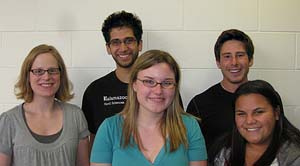
It’s summertime at K; the weather is hot, and so is the chemistry on the second floor of the Dow Science Center. In the first of a series of articles, we focus on chemistry research underway on campus during summer 2013.
Three students are advancing ongoing research projects in the inorganic chemistry laboratory of Professor of Chemistry Tom Smith. Each project is focused on elements included in a group known as transitional metals. Josh Abbott ’13, Lori-Ann Williams ’14, and Geneci Marroquin ’14 apply various techniques to characterize reactions that occur in nature (as well as some chemistry that nature doesn’t do) involving the elements vanadium (Abbott), manganese (Williams), and cobalt and nickel (Marroquin).
The researchers are working to create small molecule models that are motivated by the chemical reactions that occur in nature and involve more complex substances such as enzymes. All three are performing the intricate chemical experiments required to make crystal samples of molecules that result from the aforementioned reactions—enough samples, and of sufficient quality, for the technique known as x-ray crystallography, which will render a three-dimensional portrait of the molecule. (The notion of portraiture is particularly apt for the chemistry of transitional metals, known for their colors and alterations of color as a result of molecular changes.) The x-ray crystallography work will mean an August trip to Purdue University (the workplace of a long-time collaborator with Smith in these scientific projects) for Smith and the student researchers.
The work of Williams and Marroquin will form the basis of their respective Senior Individualized Projects. Williams’ work, says Smith, is more biologically oriented, and seeks to reconcile data on manganese compounds from Williams and the Smith lab with data published on manganese work from a laboratory in India. Marroquin’s is more “catalytically oriented, doing something nature doesn’t do,” she says. If Marroquin’s contribution to the ongoing project is successful, subsequent work may one day lead to more efficient energy generation. “We’re trying to save the world in this lab,” smiles Marroquin.
Abbott graduated in June but wanted to more research work in inorganic chemistry, the most liberal arts-ish of all chemistry disciplines. “It relates to all other branches of chemistry and science and is very useful for better understanding of peer-reviewed literature in biochemistry,” he said. His vanadium research originates from the way sea algae synthesize special organic molecules for self protection.
It’s been a good summer in Smith’s lab. All five of his researchers are “highly motivated and getting a lot done,” Smith said. (Leland O’Connor ’14 and Mojtaba Ahkavandafi ’15 were not in the lab the day we dropped in, and they are working on projects very different from those of the other students.)







